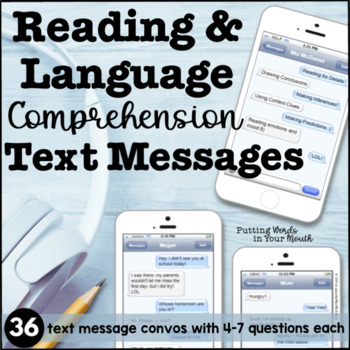Text Messages for Inferencing & Engagement Reading + Language Comprehension
- PDF
What educators are saying
Description
Highly engage your students with these, relevant, real-world language activity for the classroom or speech therapy. The short text message convos allow students (who are often struggling readers) to read confidently and use these relatable situations to practice lots of language skills (see the list below). They also spark great conversations!
⚠️ Be sure to check out the preview to see much more!
How to use and which skills are targeted;
► Students (or you) read the text messages one at a time, and then discuss them using questions included below the iPhone graphic.
► The questions provided require students to read (and possibly re-read) carefully for details, use critical thinking and apply observations (such as the time of day and names of the parties involved).
► Students are asked to perform these crucial academic language skills:
- inferencing (120 questions included)
- justifying their responses or citing evidence from the text (15 questions)
- explaining figurative language (7 questions)
- making predictions (7 questions)
- analyzing emotions (7 questions)
- proposing helpful solutions (6 questions)
► Plus, a few questions for each of the
- using context clues to decipher words
- telling the main idea
- describing mood
- comparing/contrasting
- giving opinions
- A whole range of language skills are applied through this simple activity, and
students aren't bogged down in lenghty text.
► This resource is also useful for discussing the “dos and don’ts” of conversations (when communicating verbally OR through texting). Topics like repairing conversations, showing sympathy, showing support, and expressing disappointment can easily be tackled using these cards.
What's in this download
► 36 text message conversation cards along with 4-7 questions per conversation
► 6 cards featuring blank phone screens for you or your students to write on (in case there are specific scenarios you want to address or in case you want to challenge students to write their own conversations)
► 6 wild cards to use when you the whole set of cards as a game (described in the download and preview)
► Instructions for use (with options)
► a make-your-own-jean-pocket to hold the cards if desired
► The aligned Common Core Standards for grades 4-8
If you enjoy this activity, here are some related activities using text messages/cell phones and making inferences that you may also enjoy:
✱ Cell phone Role Play Activity Freebie
✱ Cell phone Role Play Activity Part 2
✱ Making Inferences and Drawing Conclusions with Text Messages
✱ Inferences and WHO Questions Boom Cards™
Thanks for considering my resources for your instruction!
⚫ Find more from me at my ➔ Website ➔ TpT ➔ IG ➔ FB ➔ YouTube ➔ Free Resource Library ➔ Pinterest





